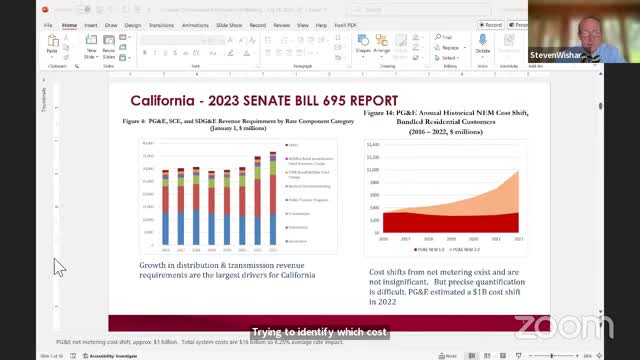California grapples with billion dollar net metering impacts
July 26, 2024 | Public Utilities Commission, Governor's Boards and Commissions, Organizations, Executive, Colorado

This article was created by AI summarizing key points discussed. AI makes mistakes, so for full details and context, please refer to the video of the full meeting. Please report any errors so we can fix them. Report an error »

In a recent government meeting, discussions highlighted significant trends in California's energy generation and distribution landscape. Notably, the state's electricity generation is experiencing a decline, attributed in part to nuclear retirements. Despite this downturn, revenue requirements for generation are also trending downward, potentially offset by an increase in purchased power.
Conversely, both distribution and transmission sectors are witnessing growth, largely driven by investments aimed at enhancing grid resilience against wildfires. These investments are crucial as California continues to grapple with the impacts of climate change and the increasing frequency of wildfires.
A key topic of discussion was the evolution of net metering in California, which has undergone several iterations—from Net Metering 1.0 to 3.0. The latest version introduces time-of-use rates and various charges for energy exported back to the grid. The financial implications of these changes are significant, with estimates suggesting that net metering adjustments could cost around one billion dollars for Pacific Gas and Electric (PG&E), which operates with total revenues of approximately 16 billion dollars. This stark contrast in cost impacts compared to states like Colorado, where solar penetration is lower, underscores the ongoing challenges related to energy affordability in California.
As the state navigates these complex energy dynamics, the focus remains on balancing sustainable energy practices with economic viability for consumers.
Conversely, both distribution and transmission sectors are witnessing growth, largely driven by investments aimed at enhancing grid resilience against wildfires. These investments are crucial as California continues to grapple with the impacts of climate change and the increasing frequency of wildfires.
A key topic of discussion was the evolution of net metering in California, which has undergone several iterations—from Net Metering 1.0 to 3.0. The latest version introduces time-of-use rates and various charges for energy exported back to the grid. The financial implications of these changes are significant, with estimates suggesting that net metering adjustments could cost around one billion dollars for Pacific Gas and Electric (PG&E), which operates with total revenues of approximately 16 billion dollars. This stark contrast in cost impacts compared to states like Colorado, where solar penetration is lower, underscores the ongoing challenges related to energy affordability in California.
As the state navigates these complex energy dynamics, the focus remains on balancing sustainable energy practices with economic viability for consumers.
View full meeting
This article is based on a recent meeting—watch the full video and explore the complete transcript for deeper insights into the discussion.
View full meeting
